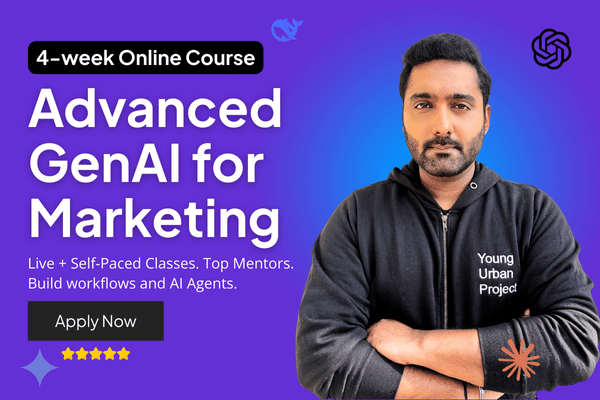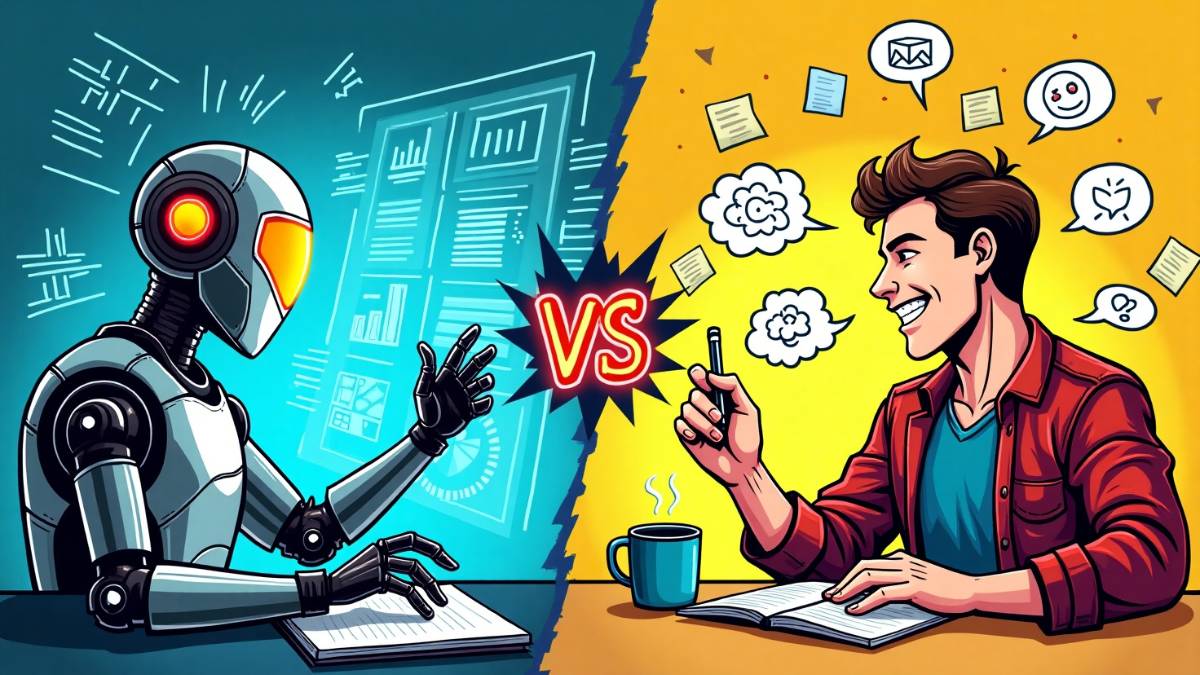Table of Contents
AI Marketing vs Human Marketing
- AI is fast, tireless, and amazing at handling massive amounts of data.
- Humans bring emotion, creativity, cultural awareness, and storytelling.
- The smartest approach? Let AI do the heavy lifting, and let humans do the thinking.
How AI Is Changing the Game in Marketing
You don’t need a crystal ball to see that AI is shaking things up in marketing. Honestly, if you’ve opened LinkedIn in the last year, you’ve probably scrolled past at least five posts about how someone “used AI to 10x their output.” And while some of that is hype, a lot of it is real.
AI isn’t replacing marketers (at least not the good ones). But it is changing how we work, often in ways we don’t even notice.
A Quick Look at the Shift
There was a time when marketing automation just meant email scheduling or setting up Google Ads rules. But now, AI tools are brainstorming headlines, writing social posts, analyzing customer data, designing images, and even recommending the best time to send an email. It’s wild.
Some of the tools you’ve probably seen or used:
- ChatGPT or Jasper for content ideas and drafts
- Midjourney for creating visuals (some of which are genuinely stunning)
- Meta Ads’ Advantage+ campaigns that optimize themselves
- Adobe Sensei, which quietly powers smart edits in Creative Cloud apps
AI is basically becoming that hyper-efficient intern who works 24/7, never complains, and never asks for a raise.
A Real-World Example: Coca-Cola
In early 2023, Coca-Cola announced it was partnering with OpenAI and Bain to explore how AI could enhance its marketing (Source). One outcome? They used generative AI to help develop creative assets for their “Real Magic” platform, like visual concepts and campaign ideas.
But, and this is key, the ideas still went through human hands. Creatives tweaked them, built on them, or rejected them completely. AI gave them a head start. It didn’t run the show.
That’s pretty much the theme here.
Why Human Creativity Still Matters in Marketing
AI is clever. But it’s not creative in the way that humans are.
Yes, it can mix and match ideas. It can predict what’s likely to get clicks. But it can’t feel anything. It doesn’t know what it means to have grown up watching Amul ads or feeling teary-eyed after seeing Dove’s “Real Beauty” film.
The Role of Intuition and Emotion
Some of the best campaigns don’t come from spreadsheets. They come from gut instinct, from observing people, from weird little insights you can’t really explain.
Remember Fevicol’s iconic ads? Like the one with the overcrowded bus, or the broken egg stuck to the wall with a Fevicol sticker on it? There’s no way a tool, even the smartest one, could’ve come up with that. Because those ideas weren’t just “logical” or “data-driven.” They were human.
Marketing isn’t just about what people say they want. It’s about what they feel but can’t articulate. That’s a very human skill: reading between the lines, picking up on cultural context, knowing when to say less.
Where AI Still Falls Short
Here’s where AI tends to struggle:
- It doesn’t really get humor, especially cultural humor.
- It can’t read a room.
- It’s bad at subtlety.
- And it has no emotional memory.
You can feed it every single brand campaign from the last decade, and it still won’t “know” why something made people cry or laugh or feel inspired.
So when we say “AI can’t replace humans,” we’re not being sentimental. We’re being practical.
AI + Human = The New Marketing Dream Team
Here’s the honest truth: AI and human marketers are not in competition. They’re doing different jobs. The tension only comes when we try to force one to be the other.
Smart brands already know this.
Case in Point: Sephora
Sephora uses AI to give customers product suggestions based on their skin tone, past purchases, and shopping habits. It’s personal, efficient, and honestly helpful.
But the overall brand tone? The design of campaigns? The voice in their social media? Still very human.
This is a great model to follow:
- Let AI handle the stuff that’s repetitive or data-heavy.
- Let humans focus on meaning, emotion, and strategy.
Together, they move faster and think deeper.
What AI Is Really Good At
Let’s give credit where it’s due. AI isn’t “creative,” but it is brilliant at a few things.
1. Handling Huge Amounts of Data
AI can look at thousands of interactions, patterns, and trends and spot connections in seconds. Tools like HubSpot, Adobe Sensei, and GA4 now offer insights that would’ve taken entire teams weeks to uncover.
2. Predicting What Might Happen
Using predictive analytics, tools like Salesforce Einstein can forecast customer behavior. Not with 100% accuracy, but often enough to give marketers a real edge.
3. Optimizing Ads
Platforms like Google Performance Max automatically adjust creatives, bids, and targeting to get better results. You set the strategy; AI does the execution.
4. Personalizing Content
Ever wondered how Netflix seems to “know” what thumbnail will make you click? That’s AI testing and adapting in the background. Email tools do this too, tailoring subject lines, recommendations, and content blocks in real time.
Bottom line: AI is like a supercharged assistant. It can’t make decisions for you, but it makes it easier (and faster) for you to make the right ones.
What Humans Still Do Better
Even as AI gets smarter, there are some areas where it’s just… not going to catch up anytime soon.
1. Emotional Storytelling
Good storytelling connects. It taps into people’s fears, dreams, memories, and hopes. That comes from life experience, not code.
2. Defining a Brand
AI can imitate a brand’s tone if you feed it enough examples. But defining that tone from scratch? That’s a human job. It takes alignment, vision, and a deep understanding of people.
3. Navigating the Grey Areas
Real-life marketing is full of fuzzy moments: a PR crisis, a sudden trend, a culture shift. You need humans who can interpret those moments and respond with empathy and nuance.
4. Breaking the Rules (When It Matters)
Some of the best campaigns succeed because they ignore what the data says. They take risks. AI can’t do that, it optimizes for what’s likely, not what’s bold.
Where AI Still Falls Short
Let’s be fair here, AI isn’t useless. But it does have blind spots. And in marketing, those blind spots can be a big deal.
1. No Emotional Intelligence
AI doesn’t feel. That’s not a dig, it’s just the truth. It can analyze a thousand sad stories and still not feel what sadness is. That means it can’t fully understand the emotional impact of a campaign or sense when something feels… off.
You know those awkward automated replies on Twitter when a brand tries to respond to a crisis with a templated message? That’s what happens when emotion is left out of the equation.
2. Over-Reliance on Past Data
AI needs a pattern to make a prediction. That works great if things stay the same. But marketing thrives on change.
Trends come and go, memes explode out of nowhere, and sometimes people just want something weird and different. AI struggles with that level of unpredictability.
3. Generic Output (If You’re Not Careful)
Ask ChatGPT to write five Instagram captions about a new product, and they’ll probably sound… okay. But also pretty bland. Without a sharp prompt and strong creative direction, most AI-generated content sounds like it was written by, well, a machine.
4. Struggles with Humor and Context
Humor is one of the hardest things for AI to grasp. What’s funny in Delhi might not land in Mumbai. What’s funny to Gen Z might confuse millennials. AI can get you close, but the final punchline? That’s human work.
Can AI Replace Human Marketers?
Let’s put this debate to rest: No. AI cannot replace human marketers.
And honestly, that’s the wrong question.
The better question is: How can marketers use AI to be better at what they already do?
What the Experts Say
According to new IBM research, 42% of large enterprises (1,000+ employees) are already using AI in their operations, and nearly 60% of those early adopters plan to scale up their AI investments even further.
But growth isn’t without friction. Many companies still face real challenges: finding talent with the right skills, making sense of complex data, and navigating ethical concerns.
And here’s the key part, AI isn’t replacing marketers. It’s being added to help them. Even companies like Salesforce, which build some of the most powerful marketing AI out there, emphasize one thing: strategy still comes from humans.
AI might help you write subject lines faster. But deciding what message really matters? That’s still your job.
AI vs Human Intelligence: Side-by-Side in a Marketing Context
| Aspect | AI in Marketing | Humans in Marketing |
| Speed | Processes data instantly | Takes longer but adds depth |
| Creativity | Based on existing data, trends, and patterns | Original, emotional, influenced by lived experience |
| Empathy | None | High, understands tone, timing, mood |
| Scale | Works globally, 24/7 | Limited by bandwidth and team size |
| Strategy | Needs direction to follow | Can invent, pivot, challenge norms |
| Storytelling | Struggles to connect emotionally | Brings heart and human connection |
This isn’t about which one wins. It’s about using both intentionally.

Enroll Now: AI Marketing Course
Pros and Cons: AI and Human Approaches to Marketing
Here’s a simple breakdown of when to go AI, when to go human, and when to mix the two.
| Use Case | AI | Human |
| Ad Copy A/B Testing | Great at speed & scale | Not worth the manual effort |
| Long-Form Thought Leadership | Lacks insight | Needs human POV |
| Social Media Captioning | Great starting point | Needs final polish |
| Data Analysis & Reporting | Automated, accurate | Too slow manually |
| Branding & Tone of Voice | Lacks nuance | Needs deep understanding |
| Email Personalization at Scale | Excellent | Strategic layer needed |
| Crisis Response | Dangerously tone-deaf | Requires empathy |
| Cultural Moments & Memes | Misses the moment | Lives the moment |
Example? For a performance marketing campaign that needs 200 ad variations, AI is your best friend. But for a brand campaign that aims to touch hearts or challenge norms? Human all the way.
Examples of AI-Human Collaboration in Real Campaigns
1. Nike: Data Meets Emotion
Nike has been using AI-driven insights to understand customer behavior, product demand, and inventory planning. But the heart of its campaigns, whether it’s “Dream Crazy” with Colin Kaepernick or the tribute to Serena Williams, comes from a deeply human place. That blend is why they stay ahead.
2. Netflix: Personalized at Scale
Netflix uses AI to recommend shows, customize thumbnails, and decide what trailers to auto-play. But the actual content? The shows that make people binge all weekend? Created by writers, directors, editors, and storytellers. Netflix has mastered the “AI for delivery, human for meaning” combo.
3. Zomato: Human Quirks, Machine Efficiency
Their push notifications are legendary. “Hey, you’ve been working hard. You deserve biryani.” That tone? That humor? That’s a team of writers who understand Indian culture, food cravings, and what makes people smile. AI might help analyze response rates, but the idea came from people.
What the Future of Marketing Might Look Like
This part is still unfolding, but here’s what seems likely:
1. Rise of Multimodal AI
We’re entering the era of Multimodal AI, tools that understand text, images, video, and voice together. Platforms like Runway, Sora, and Claude are making content creation faster and more fluid, helping marketers bring ideas to life across formats in one seamless flow.
2. New Skills for Marketers
If you’re in marketing, you don’t need to become a data scientist, but you do need to understand how AI works. Prompt writing, tool selection, creative oversight, these will all become essential skills.
The marketers who thrive will be the ones who can blend creativity with tech literacy.
3. The “Human-in-the-Loop” Model
We’ll probably see more workflows where AI handles the grunt work, and humans step in to make key decisions. Like an assembly line where machines do the heavy lifting, but people give the product its soul.
Think of it this way: AI builds the frame, but humans paint the picture.
Conclusion: The Best Marketing is Human-Led, AI-Powered
We don’t need to fear AI in marketing. We need to understand it.
AI can help us move faster, test better, and reach more people. But it’s up to humans to make sure we’re telling stories that matter, stories that are real, emotional, and rooted in culture.
The future doesn’t belong to AI.
It belongs to marketers who know how to use AI without losing their humanity.
Because tools don’t make great marketing. People do.
TL;DR – Final Takeaways
- AI is excellent at data, personalization, automation, and optimization.
- Humans excel at emotion, strategy, storytelling, and cultural nuance.
- Marketing is no longer AI vs humans. It’s AI plus humans.
- The best campaigns are still born from ideas, not algorithms.
- Marketers who embrace AI (without depending entirely on it) will win.
FAQ: AI Marketing vs Human Marketing
Q1: Can AI fully replace human marketers?
No. AI can support marketers, but it lacks emotional intelligence, creative vision, and strategic insight.
Q2: What are the advantages of AI in digital marketing?
Speed, scale, automation, data analysis, real-time optimization, and personalization.
Q3: Where does human creativity still win?
In brand storytelling, humor, crisis management, and anything that requires emotional connection or cultural awareness.
Q4: What are some AI tools used in marketing today?
ChatGPT, Jasper, Midjourney, Canva AI, HubSpot, Salesforce Einstein, Adobe Sensei, and Google’s Performance Max.
Q5: Is hybrid marketing (AI + Human) the future?
Absolutely. The most effective teams are blending AI’s capabilities with human creativity and leadership.

